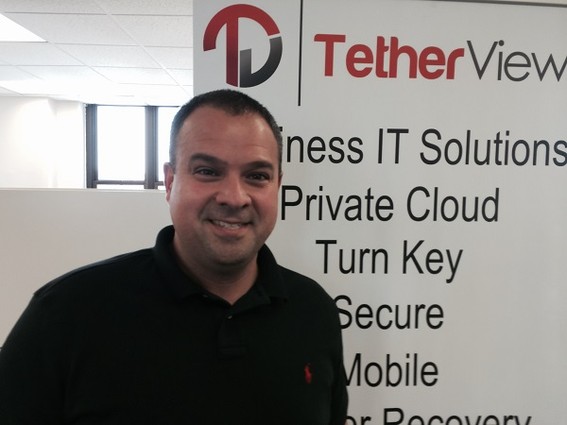Catching Up with Michael Abboud, CEO of Oceanport-based TetherView

TetherView CEO Michael Abboud recalled the long days and nights when he and a couple of engineers worked tirelessly to build the Oceanport-based private cloud solutions startup a few years ago.
“We were working into the wee hours of the night,” he said of their efforts to find a better way for businesses to meet their IT demands and save money at the same time.
Nowadays, Abboud and his staff are still working long hours, but it’s been paying off in terms of growth for the two-year-old company.
Last December, TetherView relocated its headquarters from Staten Island to its new home at the site of the former Army base at Fort Monmouth. The startup now occupies the third floor of Russel Hall and is currently renovating the rest of the building.
Plans for Tech Incubator
The company also plans to open a technology incubator in the basement of the building sometime in the fall. Businesses that complement TetherView’s focus will be eligible for free rent during the first year and possible funding the following year.
Abboud said the ex-military base is a perfect location for TetherView’s headquarters. In addition to the building’s having enough space to easily accommodate the company’s future growth, its proximity to the major business centers of New York and Philadelphia and to the state’s major highways makes for an ideal location.
The company’s setting might also appeal to prospective employees who now commute daily to jobs in New York, but would prefer to work closer to home. “There are a lot of people who don’t want to commute to Manhattan anymore,” said Abboud, who lives about a mile from the company.
On a Growth Trajectory
TetherView now has around 10,000 users of its cloud-based IT solutions, and Abboud expects that number to grow to 50,000 within the next two years.
That growth projection is partly based on the company’s strategy of partnering with other companies that could use TetherView’s services for their clients. Among these companies are Shrewsbury-based Lifeboat Distribution, a specialty software distributor for virtualization and cloud-computing services; a sister company, TechXtend (also in Shrewsbury), a provider of software, systems and services (and, like Lifeboat, a part of Wayside Technology Group); and Somerset-based SHI International, a provider of software and hardware products.
TetherView is also growing its business by launching new products and services. This summer, the company plans to introduce a file-sharing tool adapted to the standards of the federal Health Insurance Portability and Accountability Act (HIPAA), which protects medical patient data, and the Payment Card Industry Security Standards Council, a global body that establishes the criteria for the security of credit card payments. And on May 25, the company will cohost a session of a legal-education webinar series; the focus will be on how to identify, deter and respond to cyber security threats.
Virtualizing everything from Desktops to Servers
TetherView’s business model includes bundling its cloud-based solutions — including hosted virtual desktops, server hosting, application hosting and virtualization — for small, mid-sized and large enterprises.
“We take a client’s entire IT infrastructure, applications, databases, servers and desktop, and virtualize them all in one concise location,” Abboud said. “We allow our clients to access their environment from a virtual desktop, which is available from any device using any Internet connection.”
Abboud said this approach clearly differentiates TetherView from its competitors. “Very few providers are hosting servers and virtual desktops in the same infrastructure. That’s one of the unique things about us.”
TetherView keeps costs down for its clients by avoiding a lot of the complexity involved in building and designing IT environments. “We’ve got a very minimalistic approach to our technology. We want to have as few moving pieces as possible. That allows us to quickly deploy and customize the project for the client.”
The company’s pricing plan also makes it stand out from the rest of the crowd of cloud-based providers, according to Abboud.
Unique Pricing Structure
TetherView charges its clients a flat monthly fee per user, and offers a concurrent user pricing model, which means that it charges only for those users who are active on the network. For example, if one of TetherView’s clients has about 600 employees, but only 50 of them are active during a given month, the client pays only for those active employees.
Abboud said that this fee pricing arrangement is popular with companies because it gives them a more cost-effective approach to managing their IT needs. And he added, “Customers are comfortable with this plan because it’s predictable.”
TetherView’s clients mostly hail from the government, education, legal and professional services, finance, telecommunications and healthcare sectors, but Abboud noted that the company “pretty much services any business.”
One area that TetherView is focusing on is higher education. Academic institutions tend to have different IT requirements from those of most businesses. Abboud said that the company is in talks with a few universities to build and manage the IT infrastructures of their lab environments, which can change every year. TetherView will also structure the pricing plan around their academic calendars, so that the schools don’t have to pay anything to the company when the labs are closed during the summer months.
How TetherView Started
The idea of starting TetherView resulted from Abboud’s experience working with a former company. At the time, he was working on the company’s IT infrastructure, which was a patchwork of systems scattered among different locations. Abboud found the project to be both costly and time-consuming.
“We had several IT environments all over the country, and when we went to build an infrastructure to solve this problem, it turned out to be too expensive to solve it properly,” he said.
Abboud finally completed the project, but he also came to the conclusion that it could have been done more efficiently. “We realized that this wasn’t smart. It wasn’t a good [return on investment].”
Another motivation for launching TetherView was the devastation wreaked by Superstorm Sandy on homes and businesses across New Jersey. Many businesses were forced to shut down because their IT operations were destroyed or temporarily halted as a result of the storm.
Abboud noted that these businesses wouldn’t have sustained storm-related damage to their data and IT systems if they had had business-continuity and disaster-recovery programs in place. So TetherView began to offer these services, and the company now has two data centers, one in New Jersey and the other in California.
One of the biggest challenges confronting TetherView is what Abboud describes as “noise around the cloud,” or the frequent confusion over what the cloud is and what it does. Abboud spends quite a bit of his time educating companies about the different types of cloud services, and about what these companies need to ensure that their cloud solutions meet all their IT requirements.
“We’re going to make sure that we are employing the best-of-breed technology,” he said. “A main concern here is security. We try to minimize the number of points of entry into the [IT] environment.”

